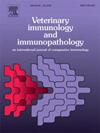1,25-二羟基维生素D3对新生儿大肠杆菌脓毒症炎症、抗菌肽和d -二聚体水平的影响
IF 1.4
3区 农林科学
Q4 IMMUNOLOGY
引用次数: 0
摘要
本研究评估了1.25-二羟基维生素D3对大肠杆菌脓毒症新生儿小牛的免疫调节、抗菌和抗凝血作用。30头新生西门塔尔犊牛分为三组:对照组(n = 10)、药物治疗组(MT;n = 10),医学治疗加维生素D3 (MT + D3;n = 10)。MT组接受标准的败血症治疗,而MT + D3组在此基础上额外给予20,000 IU/kg肌内维生素D3。于第0、1、3、5天采集血液,分析炎症因子(NF-κB、TNF-α、IL-1β、IL-10)、抗菌肽、d -二聚体、铁水平及血液学参数。在第0天和第5天评估肝脏、肾脏和心脏功能等生化指标以及钙和维生素D3水平。与MT组相比,MT + D3组表现出显著的临床和实验室改善。特别是,SpO₂水平升高,代谢性酸中毒也较早得到缓解。血液学结果显示败血症相关性贫血减少,红细胞、HGB和HCT水平保存较好。炎症因子(NF-κB、TNF-α、IL-1β)显著降低,IL-10水平得到更有效调节。较低的d -二聚体水平表明凝血平衡改善。虽然cathelicidin水平最初升高,但第5天随后下降,表明先天免疫激活受到控制。综上所述,补充维生素D3与标准治疗相结合,可有效减少新生儿败血症的全身炎症,支持先天免疫,并改善凝血功能。这些结果表明,维生素D3可能作为一个有益的辅助治疗,在牛新生儿败血症。需要进一步的研究来确定最佳的给药策略和长期临床效益。本文章由计算机程序翻译,如有差异,请以英文原文为准。
Effect of 1,25-dihydroxy vitamin D3 on inflammation, antimicrobial peptide, and D-dimer levels in Escherichia coli-induced sepsis in neonatal calves
This study evaluated the immunomodulatory, antimicrobial, and anticoagulant effects of 1.25-dihydroxy vitamin D3 in neonatal calves with Escherichia coli-induced sepsis. Thirty neonatal Simmental calves were assigned to three groups: Control (n = 10), Medical Treatment (MT; n = 10), and Medical Treatment plus vitamin D3 (MT + D3; n = 10). The MT group received standard sepsis therapy, while the MT + D3 group was additionally administered 20,000 IU/kg intramuscular vitamin D3. Blood samples were collected on days 0, 1, 3, and 5 to analyze inflammatory cytokines (NF-κB, TNF-α, IL-1β, IL-10), cathelicidin, D-dimer, iron levels, and hematological parameters. Biochemical indicators including liver, kidney, and heart function, as well as calcium and vitamin D3 levels, were assessed on days 0 and 5. The MT + D3 group showed significant clinical and laboratory improvements compared to the MT group. Notably, SpO₂ levels increased, and metabolic acidosis resolved earlier. Hematological findings indicated reduced sepsis-associated anemia, with better preservation of RBC, HGB, and HCT levels. Inflammatory cytokines (NF-κB, TNF-α, IL-1β) significantly decreased, and IL-10 levels were more effectively regulated. Lower D-dimer levels indicated improved coagulation balance. Although cathelicidin levels initially increased, their subsequent decline by day 5 suggested controlled innate immune activation. In conclusion, vitamin D3 supplementation in combination with standard treatment effectively reduced systemic inflammation, supported innate immunity, and improved coagulation in neonatal calves with sepsis. These results suggest that vitamin D3 may serve as a beneficial adjunct therapy in bovine neonatal sepsis. Further research is needed to determine optimal dosing strategies and long-term clinical benefits.
求助全文
通过发布文献求助,成功后即可免费获取论文全文。
去求助
来源期刊
CiteScore
3.40
自引率
5.60%
发文量
79
审稿时长
70 days
期刊介绍:
The journal reports basic, comparative and clinical immunology as they pertain to the animal species designated here: livestock, poultry, and fish species that are major food animals and companion animals such as cats, dogs, horses and camels, and wildlife species that act as reservoirs for food, companion or human infectious diseases, or as models for human disease.
Rodent models of infectious diseases that are of importance in the animal species indicated above,when the disease requires a level of containment that is not readily available for larger animal experimentation (ABSL3), will be considered. Papers on rabbits, lizards, guinea pigs, badgers, armadillos, elephants, antelope, and buffalo will be reviewed if the research advances our fundamental understanding of immunology, or if they act as a reservoir of infectious disease for the primary animal species designated above, or for humans. Manuscripts employing other species will be reviewed if justified as fitting into the categories above.
The following topics are appropriate: biology of cells and mechanisms of the immune system, immunochemistry, immunodeficiencies, immunodiagnosis, immunogenetics, immunopathology, immunology of infectious disease and tumors, immunoprophylaxis including vaccine development and delivery, immunological aspects of pregnancy including passive immunity, autoimmuity, neuroimmunology, and transplanatation immunology. Manuscripts that describe new genes and development of tools such as monoclonal antibodies are also of interest when part of a larger biological study. Studies employing extracts or constituents (plant extracts, feed additives or microbiome) must be sufficiently defined to be reproduced in other laboratories and also provide evidence for possible mechanisms and not simply show an effect on the immune system.

 求助内容:
求助内容: 应助结果提醒方式:
应助结果提醒方式:


